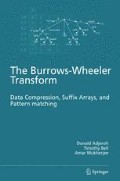Traditionally the major application of the Burrows-Wheeler Transform has been for data compression and efficient storage, and earlier chapters in this book have provided a detailed consideration of the BWT from this viewpoint, analyzing its performance for data compression. However, recent research on the Burrows-Wheeler Transform has shown the versatility of the BWT, and hence efforts are shifting from its traditional application in data compression to other areas of study. In Chapter 7 we showed how the BWT provides an effective mechanism for rapid pattern matching. In this chapter we expand more on its many uses, focusing on new and emerging applications. Some of the applications discussed in this chapter also relate to new data compression applications; given that the original purpose of the Burrows-Wheeler Transform was for text compression, it is no surprise that the method could be used for compression of other types of data. The data compression applications discussed in this chapter exploit the specific nature of the data under consideration in combination with relevant properties of the BWT to provide effective compaction of the data. We discuss the applicability of the BWT to the compression of specialized data sets, including compression of test patterns used in automatic testing in chip manufacturing, image compression, and compression of biological sequences.
Other applications described in this chapter are somewhat different from data compression, but make use of some of the special characteristics of the BWT, such as its clustering property. Examples here include its use in shape analysis in computer vision, and in machine translation.We also discuss recent reports of the application of the BWT in bioinformatics and computational biology, full-text compressed indexes, prediction and entropy estimation, and recent approaches in joint-source channel coding.
The major objective in this chapter is to show the myriad virtues of the BWT, and hopefully motivate others to think of how the BWT could be used to effectively address some important problems that at first glance may seem to be unrelated to the transform.
Access this chapter
Tax calculation will be finalised at checkout
Purchases are for personal use only
Preview
Unable to display preview. Download preview PDF.
Rights and permissions
Copyright information
© 2008 Springer Science+Business Media, LLC
About this chapter
Cite this chapter
(2008). Other applications of the Burrows-Wheeler Transform. In: The Burrows-Wheeler Transform: Data Compression, Suffix Arrays, and Pattern Matching. Springer, Boston, MA. https://doi.org/10.1007/978-0-387-78909-5_8
Download citation
DOI: https://doi.org/10.1007/978-0-387-78909-5_8
Publisher Name: Springer, Boston, MA
Print ISBN: 978-0-387-78908-8
Online ISBN: 978-0-387-78909-5
eBook Packages: Computer ScienceComputer Science (R0)

